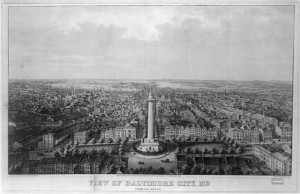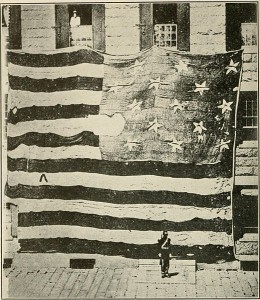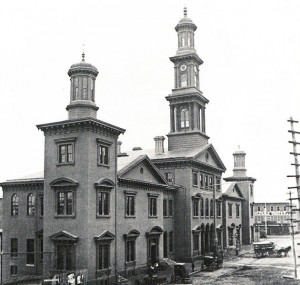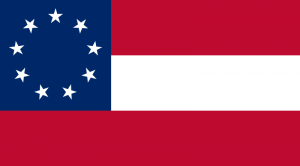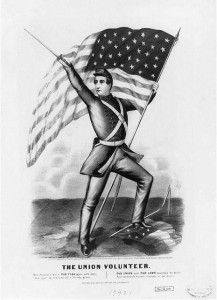Deja Vu All Over Again?*
150 years ago today the 19th New York Volunteers traveled from Harrisburg to Washington, D.C. by rail. At least, by rail most of the way. In order to change trains in Baltimore the regiment had to march through part of the city – a scenario similar to the April 19th events during the Pratt Street Riot. From Cayuga in the Field by Henry Hall and James Hall:
Glimpses of the destruction of war became visible at daylight. Blackened ruins of noble bridges encountered the eye, betokening the presence of bands of armed rebels. Soldiers with cannon now guarded the crossings at every stream. To witness these things, the volunteers crowded car doors and windows. From a passing train, word came that the regiment’s first baptism of fire was probably near at hand. Baltimore, the northern outpost of rebellion, was in a state of riotous disquietude. The city lay under the guns of Fort McHenry, on Federal Hill, where in 1814, floated the first original ” Star Spangled Banner,” concerning which the song was written. Yet, danger existed that an attack might be made on the regiment in marching through, just as, on April 19th, there had been on the 6th Massachusetts. The tidings were received with joy. Though rather deficient in such matters as street firing and battalion drill, the Cayuga boys felt their souls burn with valor and they ardently longed for an attack. They only wanted the proper provocation to clear the city at the point of the bayonet of every traitor that dwelt therein, and avenge the recent insults offered there to our flag. The Quarter-Master distributed three rounds of cartridges, each carrying an ounce ball and three buckshot Every musket received one in readiness for the expected fray.
Debarking from the cars at the head of Eutaw street, the regiment formed in column by half companies. While this was being done, disorderly crowds gathered around in the street, composed of ugly looking desperadoes, some of whom had countenances that would have made the fortune of an African gorilla.
“D —— those infernal Yankees!” “Hurrah for Jeff. Davis!”
and similar remarks were shouted on all sides. Everything looked ripe for a first-class disturbance. Before starting, Col. Clark gave the order “Fix Bayonets!” With a loud clash, 730 gleaming points of steel sprang to their places. The decidedly business-like air of this proceeding, and the wicked looking eyes of the Cayuga boys rather staggered the Baltimorean nerve, and when, with a squad of policemen in the advance, and with colors proudly flying, the regiment took up the line of march for the Washington depot at the foot of the street, the crowd gave way for it respectfully. Soon, however, the roughs grew bolder, and renewed their profanity and evil remarks, and jostled the regiment continually. Richly dressed beauties came out upon balconies and waved little secession flags and hissed as the command marched by, as though to urge on the excited populace to riot. But it did not work. The manifest coolness and determination of the regiment and its capped muskets, bluffed the turbulent element completely, checking every violent demonstration. The steadiness and nerve of the 19th was commented on admiringly by the police, who said that it saved the volunteers from the home of Seward from an attack.
Passing the Eutaw House, the regiment halted to give three tremendous cheers at the sight of a large National banner flying over it. Reaching the Washington depot a train came up after a short halt. By noon, the men were aboard and rattling over the rail to the Capital.
Camps and detachments of artillery and picket guards were passed, strewn numerously along the way, guarding .the road, every rail of which between Washington and Baltimore was precious beyond computation to the Government at this time, and was protected by either a musket or a cannon the whole distance. A few miles from Washington the loaded pieces of the regiment were discharged. The firing created a panic in the locality. Pickets, scattered through the field, thought there was a descent by the enemy and came running in. An alarm was sounded in some of the camps. The commotion partly arose from the recollection of a recent attempt on the railroad
at this point.
Washington was reached at 3 p. m. The regiment was full of enthusiasm. It had reached the National army and was now among the defenders of the Capital. The general hope was that orders to go across the Potomac at once and encamp on the sacred soil of the Old Dominion would be received. In view of the undisciplined state of the command, it was ordered into camp of instruction instead, and, pending the selection of camping ground, it was thought best to quarter it in the city. The 8th and 9th of June were accordingly spent in a tall brick building on Pennsylvania Avenue, within a few blocks of the President’s house, known as Woodard’s Hall. Seven rooms were occupied. They were unclean apartments and the regiment was glad, when, on the evening of the 10th, the command came to vacate them and go into camp.
Those 1840 muskets with bayonets that the 19th received on June 5th seem to have come in handy two days later as a deterrent.
Camden Station was a very important place because “[d]uring the four-year conflict, the B&O’s line between Baltimore and Washington, D.C. was the sole rail link between the Federal capitol and the North, resulting in a vital role for Camden Station as B&O’s Baltimore terminal.” I guess that’s another reason why Baltimore itself was so important.
* Yogi Berra

